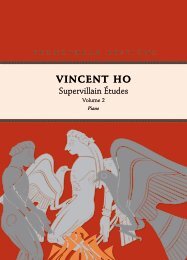Viola Concerto (Erdélyi restoration)
by Béla Bartók | Viola and Piano
by Béla Bartók | Viola and Piano
You also want an ePaper? Increase the reach of your titles
YUMPU automatically turns print PDFs into web optimized ePapers that Google loves.
corresponding instruction to indicate for how long the harmonics should continue.<br />
<strong>Erdélyi</strong> suggests returning to modo ordinario after m.151, or possibly at m.150.<br />
183–184 Only the starting notes of the ascending scale passages are given.<br />
185–187 M.185, last note and m.187, first note originally A6; harmonic editorial.<br />
189–190 Only the starting notes of the ascending scale passages are given.<br />
236–237 In the MS, these two measures appears thus:<br />
&<br />
É É<br />
# ˛ ˛# ˛# ˛ ‘ ‘ # ˛ ˛ # ˛#<br />
˛<br />
This is the sort of impractical writing for the viola that Bartók had intended to discuss<br />
later with Primrose. Playing the second four semiquavers of m.237 at the prevailing fast<br />
tempo involves an awkward string crossing which sounds unsatisfactory in this final<br />
frantic build-up. <strong>Erdélyi</strong> suggests that the desired effect might satisfactorily be created by<br />
transferring these notes to the orchestra – most likely to the viola section.<br />
Piano<br />
Movement I<br />
2–10 LH lower octave doublings are editorial.<br />
17 RH minim appears in the MS as a crotchet on beat 4; however the preceding crotchet rest<br />
on beat 3 has been crossed out.<br />
18 Note above LH upper voice: “2 clar / 1 fag”, and in the MS this line is doubled at the<br />
octave above and below.<br />
23 Note above LH GÏ4: “cl.”. Note below LH lowest voice: “fag. is?” (“bassoon too?”).<br />
53 LH tie from previous bar is editorial.<br />
54–58 The piano reduction has involved condensing a 9-part texture.<br />
In the MS, the lowest voice in mm.54 and 55 is still written in the viola staff. It is a strong<br />
supporting line for the erupting tutti, and would be inaudible if only played by the viola.<br />
The study of other of Bartók’s working drafts suggest that later in the compositional<br />
process he might have assigned these notes to other instruments (bassoon or horn, for<br />
instance).<br />
55 Note above RH beat 1 B5: “trp.”. Note above beat 2.5: “vl.”. Note above LH beat 4 FÍ4: “cor.”.<br />
68 RH beats 1 and 2 originally quavers; LH beat 2 originally a crotchet. Durations have been<br />
doubled to accommodate the retention of the triplet on the second beat in the viola part<br />
(see note above).<br />
PE066 – 38


















